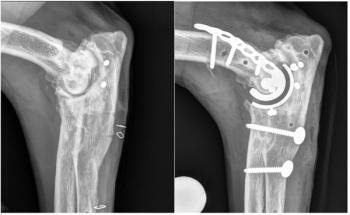
Blood gas basics (Proceedings)
Blood gas analysis gives us information about a patient's acid-base status and pulmonary function.
• Blood gas analysis gives us information about a patient's acid-base status and pulmonary function. The usefulness of this information is dependent on the users ability to accurately interpret the results.
Sampling
• Arterial samples can be taken from any artery under anesthesia. Those used most frequently include the dorsal metatarsal and coxyggeal arteries. They are also easiest to maintain a catheter for invasive blood pressure monitoring or serial sampling. Other arteries that can be used include the femoral and lingual.
• In the awake patient, the dorsal metatarsal artery is used most frequently for arterial blood gas sampling- it is recommended that a local anesthetic cream or local block be used prior to performing and arterial stick on an awake patient.
• Venous samples can be taken from any vein; central vs. peripheral is a personal preference. Venous samples give us minimal information on oxygenation status and pulmonary function but are useful in determining the metabolic status of the patient.
The analyzer
• The blood gas analyzer measures certain parameters in a blood sample
o pH
• Concentration of hydrogen ions (H+) in the blood (pH stands for per hydrogen)
o PaCO2
• Partial pressure of carbon dioxide (also seen as PCO2)
o PaO2
• Partial pressure of oxygen (also seen as PO2)
• With this information, the analyzer can then calculate these values...
o HCO3-
• Bicarbonate, a chemical buffer necessary to keep the pH of the blood from becoming to acidic or too basic
o BE
• Base excess. This value indicates the amount of excess or insufficient level of bicarbonate in the blood.
• Other analyzers have the ability to measure and calculate even more...
o Hb
• Hemoglobin
o Electrolytes
• Na+, Cl-, K+
o SaO2
• Arterial oxygen saturation
o A-a gradient
• Alveolar-arterial gradient. This is a measure of the difference between the alveolar concentration of oxygen, and the arterial concentration of oxygen. It is used in diagnosing the source of hypoxemia.
o Anion gap
• The concentration of unmeasured anions in the blood. A high anion gap may be another indicator of metabolic acidosis; a low anion gap is rare.
Relevance
• The body functions at a blood pH between 7.36-7.44 (the range is slightly different for each species but most mammals are close to this range so it is acceptable to use this range as a guide)
o The body must maintain this range at all times in order for normal metabolism to take place
o When blood pH drops below 7.36 it is considered an acidemia (acidosis is the process, acidemia is the result)
o When the blood pH rises above 7.44 it is considered an alkalemia (alkalosis is the process, alkalemia is the result)
o pH values below 6.8 or above 7.8 are significant and will interfere with cellular functioning and if left untreated, death.
Buffering systems
• Respiratory buffer system
o CO2 is a normal by-product of cellular metabolism.
o It is carried to the lungs where it combines with H2O to form carbonic acid (H2CO3). Blood pH changes depending on the amount of H2CO3 present.
o This triggers the lungs to either increase or decrease ventilation until the appropriate balance has been re-established.
• The respiratory rate will increase if too much H2CO3 is present (acidemia)
• The respiratory rate will decrease if too little H2CO3 is present (alkalemia)
o Activation of the lungs to compensate for the imbalance occurs within 1-3 minutes
o Fast, temporary response to pH derangements
• Renal buffer system
o Kidneys excrete bicarbonate (HCO3-) in the urine when the pH of the blood is too high and retain it when the pH is too low
o This method is effective, but it takes hours to days to correct an imbalance
o Long term adjustments to pH derangements
Equilibrium equation...CO2 + H2O ↔ H2CO3 ↔ HCO3- + H+
• This equation shows that carbonic acid (H2CO3) is in equilibrium with CO2, HCO3, and H+.
• As the concentration of H+ increases (lowering the blood pH) it combines with the HCO3- and shifts the equation to the left ultimately making more CO2 and H2O. The reverse is also true.
• By increasing CO2 (hypoventilation) you are shifting the equation to the right, releasing more H+, making the blood more acidic
• By deceasing CO2 (hyperventilation) you are shifting the equation to the left and pulling H+ in, making the blood more alkaline
Normals and the number 4
• Blood gas normals are easy to remember if you allow the number 4 to guide you...
o pH normal is 7.4 ± 0.04 (range of 7.36-7.44)
o PaCO2 normal is 40 ± 4 (range of 36-44 mm Hg)
o PaO2 normal minimum is 4 X the inspired concentration (room air ~ 21%; 84 mmHg, 100%; 400mmHg)
o HCO3 normal is 24 ± 4 (range is 20-28 mEq/L)
Interpretation
• Look at the pH
• Is the pH normal? Is it high (alkalemia)? Is it low (acidemia)?
o The body is meant to function at a very specific pH
• The rule of 4 tells us that normal pH is between 7.36-7.44
• If the pH is below 7.36 then an academia exists (too much acid)
• If the pH is above 7.44 then an alkalemia exists (too much base)
• If the pH is within range then the acid-base status of the patient is normal
• If you want to be more specific about the pH range, check your analyzer's reference ranges for each species
• Look at PaCO2
o If we have a pH derangement, examining PaCO2 will tell us if that derangement has a respiratory component
o Examining PaCO2 will also tell you how well your patient is ventilating
• The rule of 4 tells us that normal PaCO2 is 36-44 mm Hg
• In the face of a pH derangement...
o If the PaCO2 is high, above 44 mm Hg, then a respiratory acidosis may exist if the pH is low
o If the PaCO2 is low, below 36 mm Hg, then a respiratory alkalosis may exist if the pH is high
o If the PaCO2 is normal, then there is no respiratory component
• Taking a look at ventilation...
o If the PaCO2 is high, above 44 mm Hg, then your patient is hypoventilating with regards to CO2 production
o If the PaCO2 is low, below 36 mm Hg, then your patient is hyperventilating with regards to CO2 production
o If the PaCO2 is normal, then ventilation is adequate
• Look at PaO2
o PaO2 gives us information about how well gases are being exchanged in the lungs (both oxygen and anesthetic)
o PaO2 alerts us to hypoxemia and allows us to make changes to how we are ventilating or managing our patients
• The rule of 4 tells us that normal PaO2 should be a minimum of 4 times the inspired concentration of oxygen; 84 mmHg when the animal is breathing room air (21% O2) and 400 mmHg when on 100% oxygen.
• If the PaO2 is below normal on 100% oxygen, figure out why and take steps to correct it
o What are the 5 reasons for hypoxemia?
• Low inspired oxygen concentration
• Hypoventilation
• V/Q mismatch
• Ventilation-perfusion mismatch
• Diffusion impairment
• Thickening of alveolar membrane increasing the distance that oxygen has to travel to get the capillary
• Shunt
• True anatomical shunt where the blood bypasses the lungs and does not pick up oxygen
• Look at HCO3-
o If bicarbonate (HCO3-) is out of the normal range then a metabolic component to the pH derangement exists.
o If the bicarbonate is normal then there is no metabolic component
• The rule of 4 tells us that the normal HCO3- is 24 ± 4 (20-28 mEq/L)
• If the HCO3- is high (greater than 28 mEq/L) then a metabolic alkalosis exists
• If the HCO3- is low (less than 20 mEq/L) then a metabolic acidosis exists
• If an acid-base disorder exists...
o Determine which component (respiratory or metabolic) is responsible for the primary disorder
o The primary disorder is the component that has changed in the same manner as the pH
• If an acidemia exists, the primary disorder will be the component that corresponds to the acidosis
• Example if the pH is low and the PaCO2 is elevated (respiratory acidosis), the primary disorder is respiratory
• Example if the pH is low and the HCO3- is low (metabolic acidosis), the primary disorder is metabolic
• If both metabolic and respiratory components exist a mixed acid-base disturbance may exist
• Low pH, low HCO3-, high PaCO2
• Determine if there is a compensatory response...
o The body will often try to compensate by moving the a component in the opposite direction of the pH- if an acidemia exists, the body's response will be an alkalosis
• If the pH, HCO3 and PaCO2 are all low, then there is a primary metabolic acidosis with respiratory compensation
o The body will never over compensate
Putting it together
• Respiratory Acidosis
o pH less than 7.36 with a PaCO2 greater than 45 mm Hg
o Caused by an accumulation of CO2 lowering the pH of the blood.
o Common causes
• Hypoventilation
• CNS trauma, brain lesions
• Respiratory embarrassment
• Pneumothorax, pulmonary edema, airway obstruction, restricted chest movement
o Treatment depends on severity of acidosis and underlying cause
• Respiratory Alkalosis
o pH greater than 7.44 with a PaCO2 less than 36 mm Hg
o Caused by hyperventilation
• Can be secondary to pain, fever, anxiety
o CNS disorders (neurogenic hyperventilation)
o Overzealous ventilator therapy
o Treatment is based on the identification of underlying cause
• Metabolic Acidosis
o pH less than 7.36 with an HCO3- less than 20 mEq/L
o metabolic acidosis can be causes by either an increase in acids in the blood (other than CO2) or a deficit of base
o Common causes
• Diabetic ketoacidosis, renal insufficiency, lactic acid production (shock, sepsis, pancreatitis, hypoxemia), diarrhea, toxins (ethylene glycol, aspirin)
o Metabolic acidemia should be treated with IV bicarbonate if the pH is less than 7.1
• Metabolic Alkalosis
o pH greater than 7.44 with an HCO3- greater than 28 mEq/L
o metabolic alkalosis can be caused by either an excess of base or a loss of acid with in the body
o Common causes
• Vomiting, hyperadrenocorticism, steroid therapy, K+ depleting diuretic therapy, bicarbonate therapy
o Many patients will respond when given 0.9% saline IV because it is an acidifying crystalloid solution
Examples
pH = 7.55 pH = 7.4 pH = 7.22
PaCO2 = 24 mmHg PaCO2 = 40 mm Hg PaCO2 = 43 mmHg
PaO2 = 332 PaO2 = 110 PaO2 = 88
HCO3- = 24 mEq/L HCO3- = 24 mEq/L HCO3- = 18 mEq/L
(on 100% O2) (on 100% O2) (on room air)
pH = 7.31 pH = 7.64 pH = 6.99
PaCO2 = 55 mmHg PaCO2 = 32 mmHg PaCO2 = 60 mmHg
PaO2 = 245 PaO2 = 310 PaO2 = 100
HCO3- = 22 mEq/L HCO3- = 20 mEq/L HCO3- = 24 mEq/L
(on 100% oxygen) (on 100% oxygen) (on 100% oxygen)
Newsletter
From exam room tips to practice management insights, get trusted veterinary news delivered straight to your inbox—subscribe to dvm360.






